
Aristotelia serrata, commonly known as wineberry or in the Māori language makomako or just mako, is a small tree in the family Elaeocarpaceae, in the genus Aristotelia, found in the North Island, South Island and Stewart Island of New Zealand.

Vitex lucens, or pūriri, is an evergreen tree endemic to New Zealand.

Coprosma is a genus of flowering plants in the family Rubiaceae. It is found in New Zealand, Hawaiian Islands, Borneo, Java, New Guinea, islands of the Pacific Ocean to Australia and the Juan Fernández Islands.

Kunzea ericoides, commonly known as kānuka, kanuka, white tea-tree or burgan, is a tree or shrub in the myrtle family, Myrtaceae and is endemic to New Zealand. It has white or pink flowers similar to those of Leptospermum and from its first formal description in 1832 until 1983 was known as Leptospermum ericoides. The flowers have five petals and up to 25 stamens which are mostly longer than the petals.
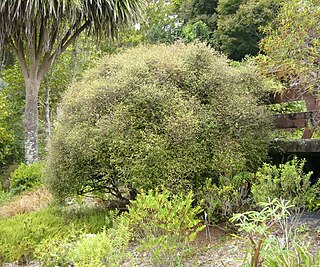
Muehlenbeckia astonii or shrubby tororaro is an endemic New Zealand shrub in the family Polygonaceae. It has distinctive small heart-shaped deciduous leaves amidst a tangle of wiry interlocking branches. Although common in cultivation around the world, it is extremely rare and threatened in the wild.
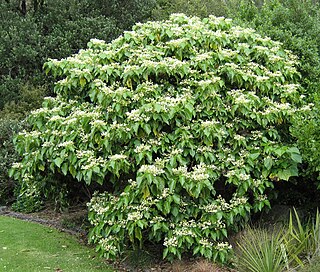
Entelea arborescens or whau is a species of malvaceous tree endemic to New Zealand. E. arborescens is the only species in the genus Entelea. A shrub or small tree to 6 m with large lime-like leaves giving a tropical appearance, whau grows in low forest along the coast of the North Island and the northern tip of the South Island. The dry fruit capsules are very distinctly brown and covered with spines. The common name whau is a Māori word that appears to derive from the common Polynesian word for hibiscus, particularly Hibiscus tiliaceus, which it superficially resembles. Alternate names include 'New Zealand mulberry', 'corkwood' and 'evergreen lime'.

Phyllocladus toatoa, known as toatoa (Māori) or blue celery pine is a species of conifer in the family Podocarpaceae, endemic to New Zealand. It was formerly referred to as P. glaucus.
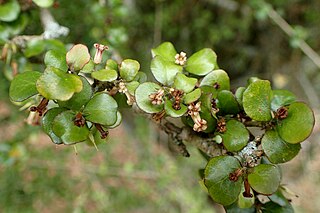
Pittosporum obcordatum, commonly called heart-leaved kohuhu or heart-leaved kohukohu or kohukohu, is a species of plant in the Pittosporaceae family. It is endemic to New Zealand, and exists both in North Island and South Island.

Coprosma rhamnoides is an endemic shrub in New Zealand. It forms a small shrub up to 2 m tall. The leaves are very small, simple and variable in shape. The inconspicuous flowers are unisexual and believed to be wind pollinated. It is widespread in occurrence and can be the dominant small leaved divaricating shrub in some locations

Myrsine australis, commonly known as māpou, red matipo, māpau, tīpau, and mataira, is a species of shrub within the family Myrsinaceae. It is endemic to New Zealand, found throughout both the mainland and offshore islands.

Coprosma propinqua is a New Zealand plant of the genus Coprosma in the family Rubiaceae. Its Māori name is mingimingi, a name which is also applied to closely related species such as C. dumosa, C. rhamnoides, C. virescens and C. crassifolia. It is a small-leaved shrub or tree which grows 3 to 6 metres high. It has divaricating branches, and is common in swampy forest, in scrub, along stream banks and in stony places. It has a wide distribution, ranging from Mangonui in the North Island as far south as Stewart Island. It grows from sea level to 460 metres.

Rubus cissoides, commonly called bush lawyer or tātarāmoa in te reo Māori, is a species of flowering plant in the family Rosaceae, endemic to New Zealand. Alan Cunningham described R. cissoides in 1839. Plants of this species of are perennial scrambling vines with compound leaves with 3-5 leaflets each up to 15 cm long, reddish prickles on the branches, white flowers from September to November and red berries from December to April. The conservation status of R. cissoides is Not Threatened, it is widespread on all three main islands of mainland New Zealand, and it has been used by Māori as food, medicines and construction materials.

Coprosma quadrifida is a dioecious shrub of the family Rubiaceae native to southeastern Australia. First described as Canthium quadrifidum by Labillardiere, it was given its current name by B. L. Robinson in 1910. Typically found at damp sites within woodlands, Eucalyptus forests or cool-temperate rainforests, it prefers sheltered slopes or sites near water sources. They are able to withstand frost and are salt tolerant. The species is also known as the Prickly Currant Bush.
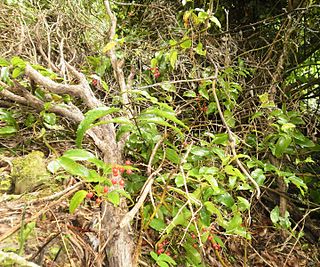
Ripogonum scandens, is a common rainforest vine native to New Zealand. It can also grow in areas of swamp.

Coprosma rotundifolia is a native forest shrub of New Zealand found on the North, South, and Stewart Islands.
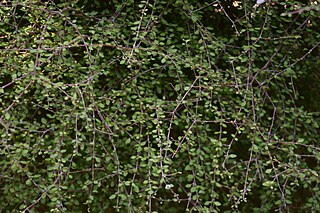
Coprosma virescens is an endemic New Zealand plant in the genus Coprosma of the family Rubiaceae. Its Māori name is mingimingi, a name which is also applied to closely related species such as C. dumosa, C. rhamnoides, C. propinqua and C. crassifolia. It is a small-leaved shrub or tree which grows 2 to 3 metres high. It has very slender, more or less glabrous divaricating branches. The small leaves are petiolate with petioles from 2mm to 5mm long. The leaves narrow suddenly at the petiole and may be up to 9 millimetres (0.35 in) long and 6 millimetres (0.24 in) wide with wavy margins or a few blunt teeth throughout South Island in lower montane forest and scrubland. The apetalous male flowers occur in axillary clusters of one to two on very short branches. Female flowers are found on their own at the ends of short branchlets.
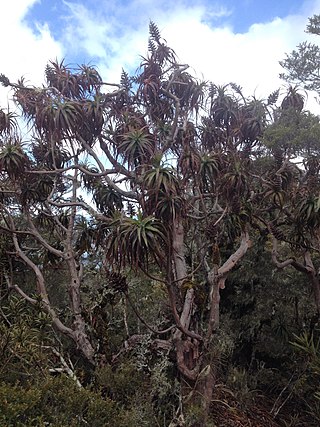
Dracophyllum traversii, commonly known as mountain neinei, grass tree, and pineapple tree is a species of flowering plant in the heath family Ericaceae. It is a deciduous tree endemic to New Zealand. It reaches a height of 0.2–13 m (0.66–42.65 ft) and has leaves which form tufts at the end of its branches. It has a lifespan of between 500 and 600 years.
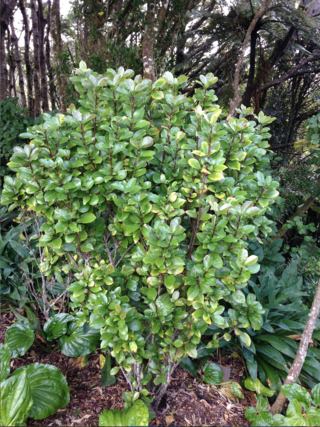
Alseuosmia quercifolia, commonly known as oak-leaved toropapa, toropapa, and karapapa (Māori), is a species of plant in the family Alseuosmiaceae. It grows as a shrub, reaching a height of 2.5 m, and has variably shaped glossy green leaves. Flowering begins in spring, producing fragrant pink flowers which become red berries in Autumn. Endemic to New Zealand, it is found only in the upper half of the North Island - predominately in the Waikato region.

Dracophyllum ophioliticum, commonly known as asbestos inaka and asbestos turpentine tree, is a species of shrub in the family Ericaceae. Endemic to New Zealand, it grows into a sprawling shrub, reaching heights of just 30–200 cm (10–80 in), and has leaves which form bunches at the end of its branches.

Scandia is a genus of flowering plants belonging to the family Apiaceae. It is also in tribe Aciphylleae, with plants, Gingidia Dawson and Lignocarpa Dawson, with all three genera being native to New Zealand. They are scrambling shrubs with white flowers.




















